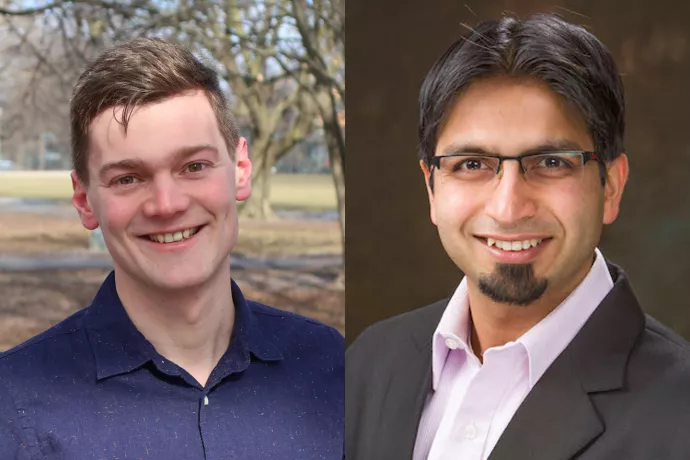
Two UTM professors awarded 2023 Sloan Research Fellowship
Two U of T Mississauga faculty have been awarded prestigious Sloan Research Fellowships. The two-year, US$75,000 awards recognize early-career researchers for outstanding contributions to their fields that mark them as next-generation leaders.
Mathematician Duncan Dauvergne and computer scientist Sushant Sachdeva were recognized for making headway on seemingly-simple problems which in fact turn out to be fiendishly difficult.
Dauvergne specializes in a broad class of problems that involve randomness and probability. Consider a spilled cup of coffee. A few droplets of coffee land on a white sheet of paper, creating a stain – but the stain is not static. Rather, the brown area expands, its outer edge creeping onto the white paper in a manner that turns out to be extremely difficult to describe in detail. Examined close-up, there’s an unavoidable random element: It’s nearly impossible to say which tiny bit of the paper will yield to the coffee next. Dauvergne has spent years modelling problems similar to the coffee-stain – phenomena like the growth of crystals, the expansion of colonies of bacteria and the spread of wildfires.
“We study these problems from a purely mathematical point of view – but they're often motivated by problems in physics, or by some sort of physical phenomena,” says Dauvergne, an assistant professor of mathematics at UTM.
Whether it’s a coffee stain, a bacteria colony, or a fire, the trick is to find how a system’s behaviour at the microscopic level bears on its large-scale evolution. Similar considerations apply to phenome like “random walks.” Suppose a person (or a dot on a computer screen) turns right or left depending on the result of a coin toss. Each individual step is random; but what does the resulting path look like after a hundred steps, or a million? “You want to understand how those simple rules control the large-scale behaviour of the system,” he says. “The physics is interesting, and the mathematics becomes very rich.”
Dauvergne’s love of math developed gradually. As an undergrad at the University of British Columbia, he studied general science. In his second year, he narrowed it down to math and chemistry, and then dropped the chemistry in favour of physics. “And then the next year, I dropped the physics and I just stuck with math.” He found himself enamored with the “way of thinking” found in mathematics. “I found there’s a lot of beauty in math proofs, and there’s a lot of room to be creative. You’re only limited by the kinds of problems you can think up.”
Sachdeva, meanwhile, was recognized for his work on something called “maximum flow” problems. As the name suggests, maximum flow problems involve maximizing the amount of stuff you can move from one place to another in a given time. Suppose you’re trying to send truckloads of goods from Vancouver to Halifax. If there was just one road, there would only be one solution. But in the real world, multiple routes are available, and, typically, they’ll have differing capacities. Think of a wide highway which, at a certain point, has a two-lane bridge. No matter how many trucks you send along the highway, the narrow bridge will limit the rate at which they reach their destination. Which means you’ll want to re-route the trucks so they avoid such bottlenecks. It sounds simple – but as the network grows, so does the complexity.
“It’s an old problem that people have been tackling for a very long time,” says Sachdeva, an assistant professor in the department of mathematical and computational sciences at UTM, who holds a cross-appointment in the computer science department at U of T.
Previous work yielded many algorithms that describe how to move goods across a network; the problem was, they were never particularly efficient. If you doubled the size of the network, for example, you more than doubled the time needed to run the algorithm.
Last year, Sachdeva, working with five other colleagues in Canada, the U.S., and Europe, found a vastly improved algorithm – one that the researchers say runs in “almost linear” time, meaning that the running time to find the solution grows in proportion to the size of the network being studied.
In a recent report on the research in Quanta magazine, one researcher describes Sachdeva’s algorithm as “absurdly fast;” another called his team’s work a “tour de force.” Sachdeva himself describes it as a “mathematical breakthrough” and a “milestone.” And yet, the payoff may not be immediate, because the various previously-known solutions are good enough for many purposes. Nonetheless, he expects his team’s work will eventually lead to new software that may see widespread use. He also looks forward to the day when this research, which he describes as “pretty technical and involved,” could be made more accessible. “Maybe even something you could teach in undergraduate classes,” he suggests.
